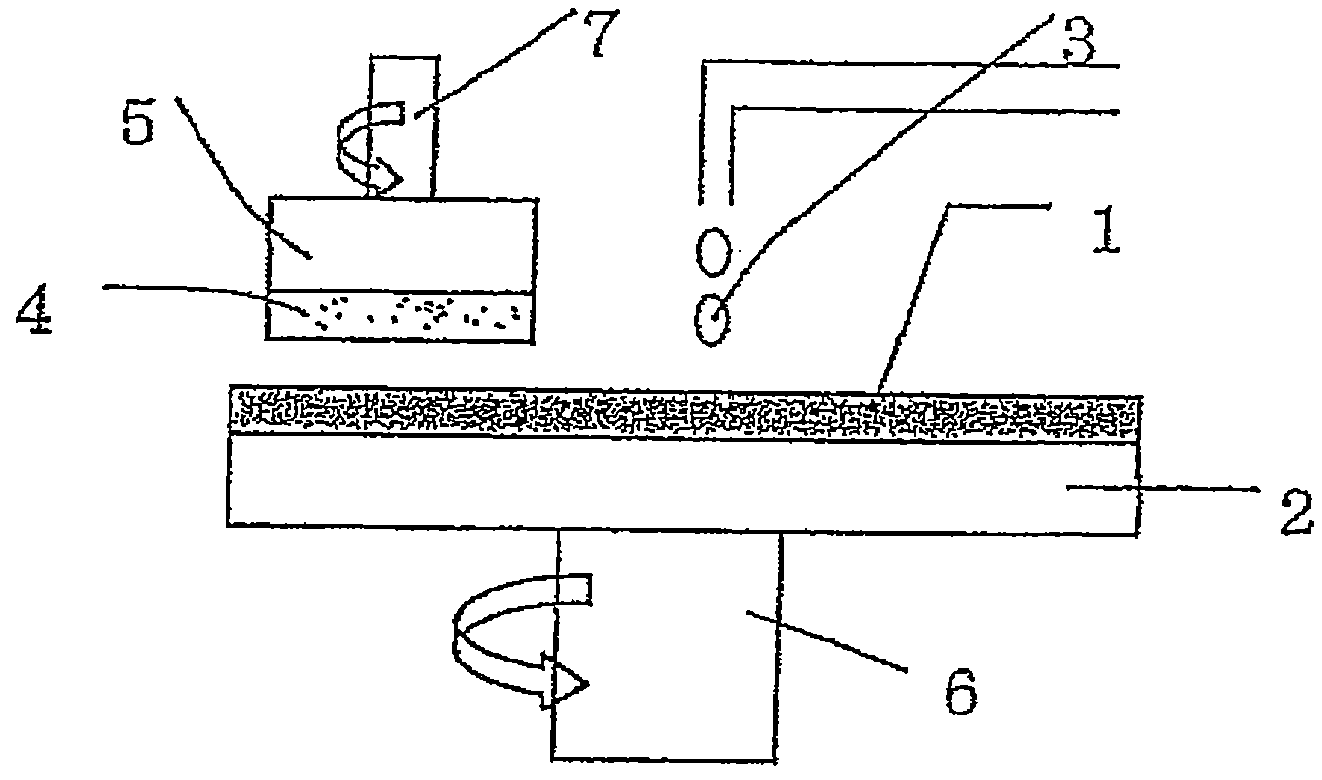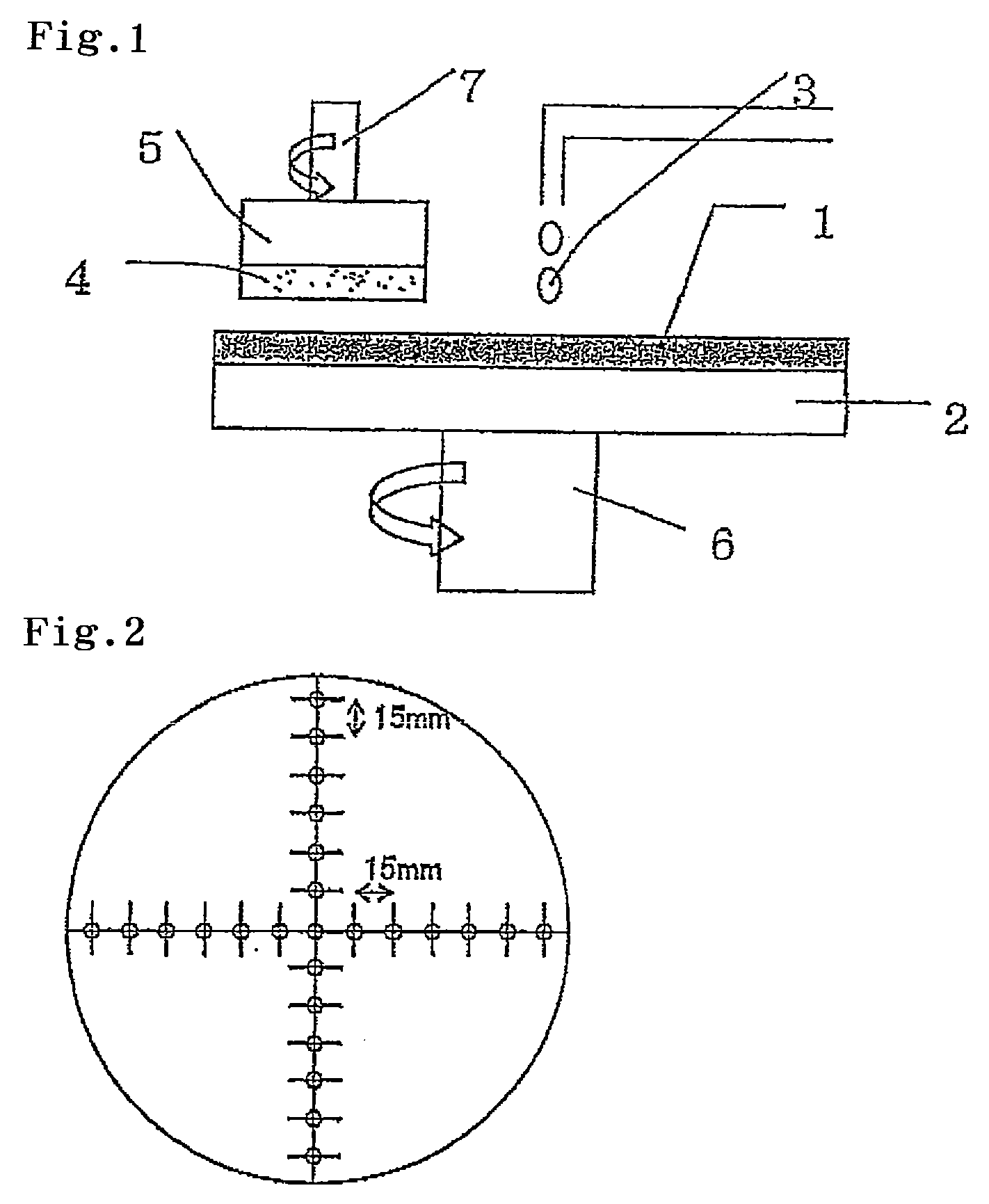Polishing pad
a technology of polishing pad and polishing surface, which is applied in the field of polishing pad, can solve the problems of unreacted polyol component remaining in the material, deteriorating inability to obtain uniform physical properties of the polishing pad, etc., and achieves superior longevity and excellent polishing rate.
- Summary
- Abstract
- Description
- Claims
- Application Information
AI Technical Summary
Benefits of technology
Problems solved by technology
Method used
Image
Examples
example 1
[0091]350 parts by weight of polytetramethylene glycol (PTMG with a number-average molecular weight of 650, manufactured by Mitsubishi Chemical Corporation) and 57 parts by weight of diethylene glycol (DEG, manufactured by Mitsubishi Chemical Corporation) were introduced into a separable flask, and dehydrated under stirring under reduced pressure for 2 hours. By introducing nitrogen into the separable flask, the atmosphere therein was replaced by nitrogen, and 300 parts by weight of toluene diisocyanate (a mixture of 2,4-diisocyanate / 2,6-diisocyanate in a ratio of 80 / 20 manufactured by Mitsui Takeda Chemicals, Inc.; hereinafter referred to as TDI-80) and 114 parts by weight of 4,4′-dicyclohexyl methane diisocyanate (hereinafter abbreviated as HMDI) were added thereto. While the temperature of the reaction system was kept at about 70° C., the reaction mixture was stirred until the reaction was finished. The reaction was regarded to be finished when NCO % became almost constant (NCO %...
example 2
[0095]1113 parts by weight of polytetramethylene glycol (PTMG with a number-average molecular weight of 1000, manufactured by Mitsubishi Chemical Corporation), 196 parts by weight of polytetramethylene glycol (PTMG with a number-average molecular weight of 650, manufactured by Mitsubishi Chemical Corporation) and 150 parts by weight of diethylene glycol (DEG, manufactured by Mitsubishi Chemical Corporation) were introduced into a separable flask, and dehydrated under stirring under reduced pressure for 2 hours. By introducing nitrogen into the separable flask, the atmosphere therein was replaced by nitrogen, and 900 parts by weight of TDI-80 and 151 parts by weight of HMDI were added thereto. While the temperature of the reaction system was kept at about 70° C., the reaction mixture was stirred until the reaction was finished. The reaction was regarded to be finished when NCO % became almost constant (NCO %=9.1). Thereafter, the reaction solution was defoamed under reduced pressure ...
example 3
[0097]A polishing pad was prepared in the same manner as in Example 1 except that 25.2 parts by weight of ETACURE 300 (a mixture of 3,5-bis(methylthio)-2,6-toluene diamine and 3,5-bis(methylthio)-2,4-toluene diamine), manufactured by Albemarle Corporation) were used in place of 28.7 parts by weight of MOCA.
PUM
| Property | Measurement | Unit |
|---|---|---|
| specific gravity | aaaaa | aaaaa |
| tensile strength | aaaaa | aaaaa |
| tensile elongation at break | aaaaa | aaaaa |
Abstract
Description
Claims
Application Information
 Login to View More
Login to View More - R&D
- Intellectual Property
- Life Sciences
- Materials
- Tech Scout
- Unparalleled Data Quality
- Higher Quality Content
- 60% Fewer Hallucinations
Browse by: Latest US Patents, China's latest patents, Technical Efficacy Thesaurus, Application Domain, Technology Topic, Popular Technical Reports.
© 2025 PatSnap. All rights reserved.Legal|Privacy policy|Modern Slavery Act Transparency Statement|Sitemap|About US| Contact US: help@patsnap.com


